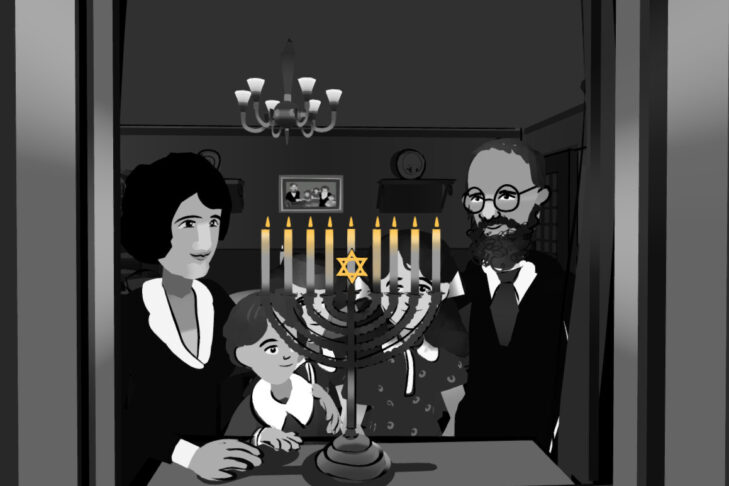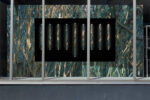Imagination alongside augmented reality is writ large in the Jewish Arts Collaborative’s new app, JArtsGallery. The augmented reality mobile app will be available for download on Dec. 9 in the iPhone app store. Laura Mandel, executive director of JArts, told JewishBoston that the venture into augmented reality is a new endeavor for the organization. “We’re planning on creating more of these virtual art galleries,” she said. “The hanukkiah gallery is just the first show on this app.”
Secret Portal, a company specializing in augmented and virtual reality, is the creative force behind the virtual art gallery, which features four hanukkiyot, or menorahs. (In the interest of full disclosure, Mandel’s husband is a founder of Secret Portal.) Mandel pointed out the story behind the first gallery exhibit that attendees will encounter—“Facing the Flag” revolves around a photograph from 1932 showing the Posner family celebrating Hanukkah in Kiel, Germany, in defiance of the Nazi regime.
The exhibit incorporates a photograph that Rachel Posner, the wife of Rabbi Akiva Posner, took of the family’s menorah. The family placed the menorah against the backdrop of a building across the street that was festooned with Nazi flags. With permission from the Posner family’s descendants, Secret Portal’s artists took the image to reimagine that long-ago Hanukkah celebrated on the cusp of Nazism’s rise. The family immigrated to Palestine in the late 1930s and donated the menorah to Yad Vashem, which has allowed JArts to display a three-dimensional version of the heirloom. “The idea is that when you look inside the window, it functions as a portal into your wall,” Mandel explained. “When you hold your phone up and look straight out, you see the street and you see the Nazi flag. When you look inside, you rotate yourself around and see the family inside celebrating Hanukkah.”
Related
The piece highlights that in the Diaspora, a dreidel is stamped with letters that stand for nes gadol haya sham—“a great miracle happened there.” In contrast, the letters on a dreidel in Israel stand for nes gadol haya po—“a great miracle happened here.” “Through this portal concept, you’ll be able to look inside as if you’re in the United States, where it will note ‘a great miracle happened there.’ If you look outside the portal, it will say ‘a great miracle happened here,’ said Mandel. “The piece portrays this idea that through augmented reality, we can be anywhere. It highlights the understanding and connection of what those phrases mean in different places.”
Digital artist and sculptor Jeff Hesser’s ambitious and intriguing piece builds on the image of an abstract menorah. Called “Untitled,” JArts describes the work as “beginning in your home but extending through your ceiling into a vast, evocative virtual space. Towering above you, the peaceful motion is driven by musical themes of wonder.”
Zachary Oxman, the White House hanukkiah artist and sculptor, created a bronze menorah whose candleholders are shaped liked dancers’ bodies. JArts describes this piece as “honoring the diversity of the Jewish people and how they are connected through traditional song and dance.” The menorah is meant to be recreated three-dimensionally on the floor, where the figures will morph into a global representation of Jews dancing and celebrating the holiday.
Mandel emphasized that the four menorahs featured in the virtual show are more than art exhibits. “It’s about telling the stories behind these four menorahs,” she said. “Each of them is a mini vignette or interactive short film that you can view through your iPhone.”




